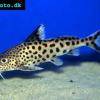Angel squeaker - Synodontis angelicus
Scientific name: Synodontis angelicus
Common name: Angel squeaker
Family: Mochokidae
Usual size in fish tanks: 20 - 30 cm (7.87 - 11.81 inch)
014
Recommended pH range: 6 - 8
Recommended water hardness: 6 - 19°N (107.14 - 339.29ppm)
0°C 32°F30°C 86°F
Recommended temperature range: 24 - 29 °C (75.2 - 84.2°F)
The way how these fish reproduce: Spawning
Where the species comes from: Africa
Temperament to its own species: peaceful
Temperament toward other fish species: peaceful
Usual place in the tank: Bottom levels
Food and Feeding
The Angel Squeaker (Synodontis angelicus) is an omnivorous species that is not particularly picky when it comes to food. In the aquarium, they will thrive on a varied diet that includes high-quality sinking pellets, spirulina discs, and algae wafers as the foundation of their diet. To encourage optimal growth and enhance coloration, it is beneficial to add protein-rich treats such as brine shrimp and bloodworms. Additionally, incorporating live or frozen foods into their diet will help stimulate natural foraging behaviors and contribute to their overall health. Offering a balanced mix of plant-based and protein-rich foods will keep them both active and healthy.
Origin
The Angel Squeaker is native to the Congo River Basin in Central Africa, primarily inhabiting slow-moving or still waters with soft, sandy or muddy substrates. In the wild, they are often found hiding among rocks, submerged wood, and dense vegetation, where they feel protected and can easily forage for food. These habitats are typically warm, slightly acidic to neutral, and well-oxygenated, which should be replicated in a home aquarium to provide a comfortable and stress-free environment for this species.
Sexing
Distinguishing between male and female Angel Squeakers can be challenging, as there are few visible differences between the sexes. The most reliable method is to examine the genital papilla, which is easier to observe in mature fish. Males have a ridged, extended genital papilla, whereas females display two small pores: the oviduct and the anus. This process requires experience and a careful eye, as the differences can be subtle.
Breeding
Breeding the Angel Squeaker in home aquariums has not yet been documented, likely due to their specific breeding requirements and natural spawning behavior. In their natural habitat, they are believed to be egg scatterers, meaning they release eggs over a wide area, often among dense vegetation or rocky substrates. Replicating these conditions in an aquarium can be challenging. Additionally, their solitary and territorial nature can make breeding attempts difficult. Aquarists interested in breeding this species may benefit from setting up a dedicated breeding tank with soft substrate, dim lighting, and plenty of hiding spots to increase the likelihood of successful spawning.
Lifespan
With proper care, the Angel Squeaker can live for 5 to 8 years in captivity, though some well-maintained specimens have been reported to live even longer. Maintaining stable water quality, providing a balanced diet, and ensuring a suitable habitat are essential factors in supporting their longevity.
Tank Requirements
The Angel Squeaker requires a well-structured tank environment that mimics its natural habitat. A tank of at least 150 liters (40 gallons) is recommended for one adult specimen, with larger tanks needed if keeping more than one. These fish prefer tanks with low lighting, ample hiding places, and a soft, sandy substrate that allows them to engage in their natural foraging behavior without risking damage to their delicate barbels. Smooth rocks, caves, and broad-leaved plants such as Anubias or Java fern are ideal additions, as they provide cover while allowing the fish to explore their surroundings comfortably.
Water parameters should be kept within a pH range of 6.0 to 8.0 and a temperature range of 24-29°C (75-84°F). Soft to moderately hard water is preferred, though they are quite adaptable to different water conditions as long as they are stable. Regular water changes and a good filtration system are essential to maintain water quality, as this species can be sensitive to pollutants.
Short Description
The Angel Squeaker, also known as the Angelicus Catfish, is a peaceful, bottom-dwelling species from the Congo River Basin in Central Africa. Known for its distinctive pattern of spots and a unique body shape, this species makes a visually striking addition to larger aquariums. With their nocturnal nature, they are often most active at night, making them an interesting choice for experienced aquarists. Although adaptable to a variety of water conditions, they require plenty of hiding places and a well-maintained tank with stable parameters. They are suitable for community tanks with other peaceful species of similar size and temperament, but be mindful to avoid overly aggressive tankmates that may stress them. This unique and peaceful fish is sure to add charm and interest to any aquarium.
Picture
Bought by aqua-fish.net from jjphoto.dk.


 Euchilichthys
Euchilichthys  Brichard’s
Brichard’s  Decorated
Decorated  Featherfin
Featherfin  Orangestriped
Orangestriped  Cuckoo
Cuckoo  Lace
Lace  Upside-down
Upside-down  One
One  Ocellated
Ocellated  Robert’s
Robert’s